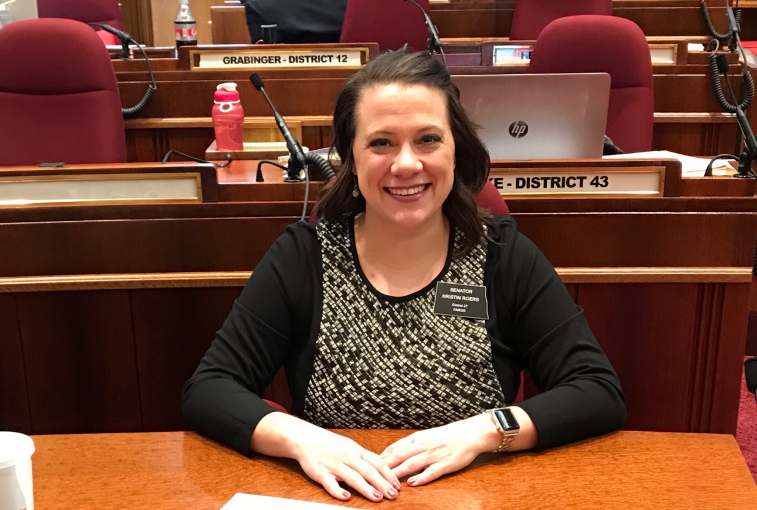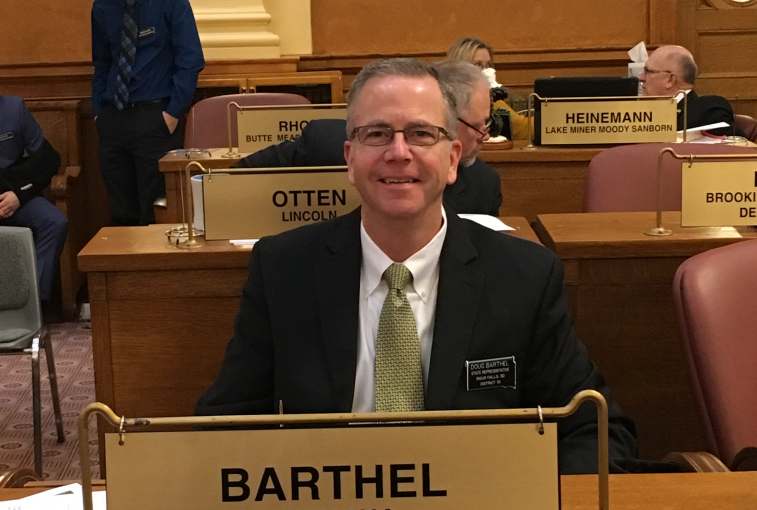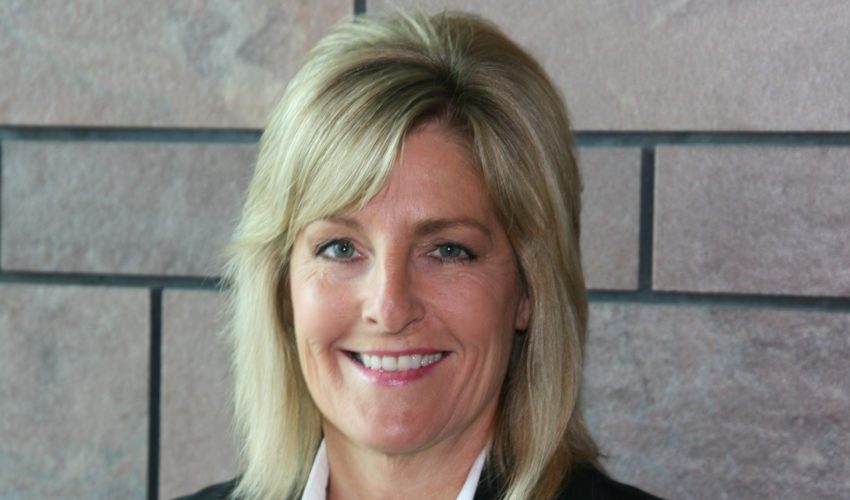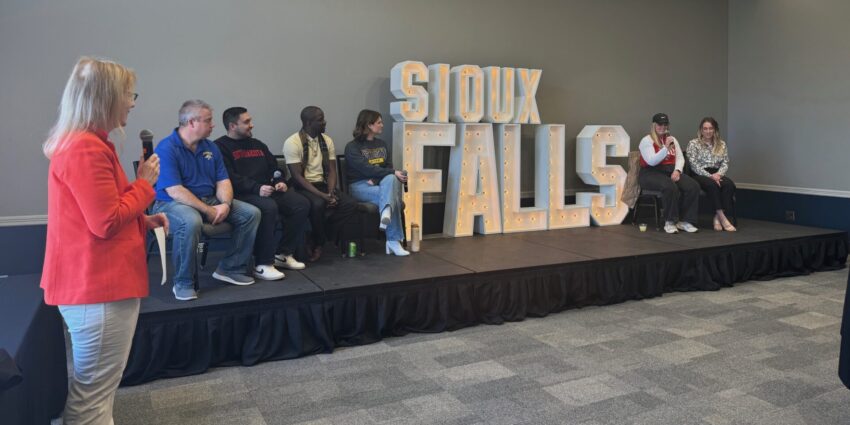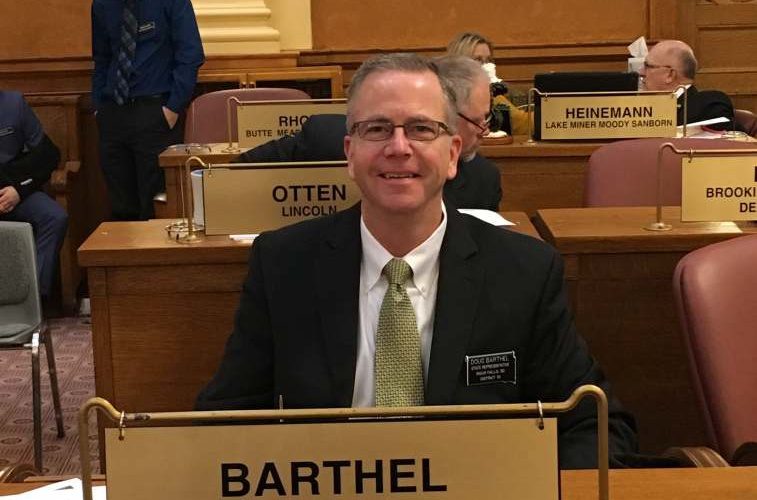Sanford Health employees share health care, legislative roles
Jan. 11, 2019
This paid piece is sponsored by Sanford Health.
It’s a good thing Kristin Roers likes to bake. She’s relying on that skill to stay in the good graces of her colleagues at the Sanford Health Office of Nursing Practice in Fargo as she heads to her first term in the North Dakota Legislature.
“I’ve been feeding my co-workers cookies to make up for the fact that they have to pick up all my work,” Roers said.
For the next four months in Bismarck, Roers will give up her work as a self-described “project manager for nursing” to instead sift through hundreds of legislative bills as a Republican state senator. Rather than help nurses with policies, procedures and supplies when developments such as new software or equipment come out, she’ll spend five days a week working with 140 others selected by voters to help improve the lives of all North Dakotans.
Fellow Sanford Health employee Doug Barthel won’t escape entirely his duties as senior public affairs specialist during his term as a Republican representative in the South Dakota Legislature. Lawmakers gather in Pierre for four days a week for two months, but Barthel will be back in his office in Sioux Falls on that fifth day. He’ll also be in contact via phone and email in between. That’s just as well — Sanford Health seems to suit the former Sioux Falls police chief, who just marked his third anniversary with the organization.
“It’s like a big family,” Barthel said. “It makes it fun to come to work.”
A sizable number of legislative bills touch on health care issues, and having people with that background can only help with decisions that may affect the well-being of all, Barthel and Roers said.
“The leadership team said having someone out there who understands health care is a benefit to Sanford,” Roers said.
Barthel’s path to Pierre
This session is the second for Barthel, 56, who was elected in November to a South Dakota House seat in District 10. He served in the 2018 session after Gov. Dennis Daugaard appointed him to fill a vacant seat.
“There were parts of public service that I missed,” Barthel said of his decision to put his name in for the appointment after retiring from the police force.
Barthel cited two core qualities — relationship-building and communicating — that his experiences in law enforcement, public affairs and lawmaking all have in common.
Glancing at a week in his December schedule showed his commitment to using those qualities as he prepared for the upcoming session. Outside of the hours of his “day job,” he had events to help build relationships over breakfast, lunch and dinner most days of the week.
‘Dot-connector’
Communication and persuasion are fundamental to law enforcement, Barthel believes. “Ninety percent of what police officers do, they can do with their mouth.”
At Sanford Health, he counts himself as one of the “dot-connectors.” Through his network of connections in the world of elected offices, government and business, he introduces people who have questions to other people who have the answers.
And now, part of his job in the Legislature is to build connections and trust, and try to persuade other legislators.
In his first session, Barthel said, “I developed some great relationships — across the state as well as local.”
That part was familiar. Other aspects of his first session, not so much.
“It was like my first day at school,” Barthel said about heading to Pierre as a new lawmaker. He had to navigate a new process, procedures and formalities. And for the first time in his career, he didn’t have a traditional boss. “There was no one to tell me what to do.”
Barthel seemed grateful and inspired, though, as he talked about getting help from a lot of people in his first session and his intent to pay it forward to newcomers in the 2019 Legislature.
Looking ahead
Initially in 2018, Barthel didn’t sponsor any original legislation, but he did end up becoming a sponsor on four or five bills. When considering whether to sponsor a bill, he likes to talk to people who might be affected, including state agencies, to determine the type of support it might have.
Barthel is involved with the South Dakota Public Safety Communications Council and with The Compass Center board in Sioux Falls. Through those connections, he foresees possible legislation on the state radio system for first responders and on human trafficking.
He’ll also work to develop relationships with new legislators and the new members of the administration of Gov. Kristi Noem, as well as new Attorney General Jason Ravnsborg.
Barthel wonders whether the changes in the Legislature and governor’s office will mean fewer bills will be introduced this year or failed bills from past sessions will reappear.
Roers claims her own seat
Kristin Roers won her first election since college in November when she earned a North Dakota Senate seat for District 27. However, in her service as vice president of government relations for the North Dakota Nurses Association, Roers had already spent time at the Legislature in Bismarck. “I was their unpaid volunteer lobbyist,” she joked.
The 41-year-old Sioux Falls native also had served as a page at the South Dakota Legislature for two weeks during high school. She was sponsored by then-lawmaker Barb Everist, who currently serves on the Sanford Health board of trustees.
From the Legislature to Sanford Health
Another Sanford Health employee with deep statehouse roots is Corey Brown, who served eight years in the South Dakota Legislature from Gettysburg in District 23, which covers a geographic area larger than Connecticut.
He held about as many leadership positions as the Senate offers. These days, he heads to Pierre from his home in Sioux Falls instead. And now, he’s advocating for Sanford Health on a significant number of the 500 or so bills that get proposed.
“Fifteen to 20 percent of bills have a direct or indirect connection to health care,” Brown said.
The senior legislative affairs specialist has been in his role for about a year. This is his second session in Pierre, and he’ll spend time in Bismarck as well. Given the complexity of many health care issues, lawmakers with an understanding of the health care field are a bonus, and they can help point out unintended consequences of bills.
“Anytime you can have people come from that background, I think that helps,” Brown said.
His job at each legislative session is to interact with lawmakers and state agency officials to educate them, try to help guide policy and share Sanford Health’s vision for health care. The organization also contracts with lobbyists in North Dakota and South Dakota, and plans to become more active in Minnesota because of its clinics and hospitals there.
Issues coming up
One of the major issues Brown sees for South Dakota is reimbursement rates to providers for Medicaid long-term care. Of the patients in an average nursing home, he estimates 55 percent to 60 percent are on Medicaid. The joint state and federal program helps low-income people receive medical care, including nursing home stays.
Medicaid rates set by the state that fall significantly short of covering the actual cost of care can have the effect of increasing the rates for private-pay residents of long-term care, as well as delaying improvements to aging facilities. In South Dakota, Brown said, three nursing homes have closed recently, and two more are slated to. With the new Sanford Health-Good Samaritan Society affiliation, this issue seems likely to gain even more relevance.
Meanwhile, North Dakota, unlike South Dakota, has opted to expand Medicaid to cover more people. The Medicaid expansion coverage is provided by the Sanford Health Plan. That expansion must be reauthorized every two years, so Brown is keeping a close eye on it this session. He’s also watching expansion rates. At this point, reauthorization looks likely, he said.
Similarly, the North Dakota Legislature also is tasked with authorizing funds for the health plan of the North Dakota Public Employees Retirement System, whose carrier is the Sanford Health Plan. The organization’s board renewed the contract with Sanford Health Plan in September, but it won’t be signed until the legislative session is over. “We look like we’re on the right track there,” Brown said.
A shift in payment model
In addition, in a big-picture look at health care funding, there are signs of movement toward paying providers a set rate to manage the overall care and well-being of a patient, rather than paying a set fee for individual services provided such as tests and procedures. Essentially, it’s an emphasis on the quality of care versus the quantity of services provided.
Brown thinks North Dakota could be open to trying this method of managing care with Medicaid. An example of legislation that could advance this from theory to practice in the state would be to try a pilot program. A health care organization could have a certain amount of money allocated for each patient to focus on their health care, rather than submitting an itemized bill for office visits, tests and procedures.
It’s a model that Sanford Health has spent years working toward, according to Luke Lindberg, corporate administration adviser for Sanford Health.
Lindberg sees it benefiting patients with better outcomes and saving the state money at the same time. He’s ready to explore this with Noem’s incoming administration in South Dakota.
Federal issue
On a federal level, Sanford Health contracts with two lobbying firms to help share its vision with the president’s administration and U.S. senators and representatives.
One high-priority issue, Lindberg said, is trying to maintain the level of the 340B Program. The pharmaceutical drug discount pricing program has experienced previous cuts. In the program, manufacturers participating in Medicaid agree to provide outpatient drugs to eligible health care organizations at reduced prices. The U.S. Department of Health and Human Services manages the program, but no federal money goes into it.
The program and any actions taken with it are significant to Sanford Health because hospitals serving rural and low-income populations are most affected. It’s a rare time when a hospital in Chamberlain, for example, has a similar stake as a hospital in Chicago.
For this particular issue, the lobbyists focus on meeting with HHS and other members of the administration. The administration is where most of the action on this issue takes place. Sanford also has worked to educate and has found support from members of Congress in Sanford’s footprint. But Congress as a whole tends to be reluctant to act on something so complex. “Health care is probably the most complicated issue in D.C.,” Lindberg said.
Sometimes, even state legislative bills that come up can require real thought before Sanford Health takes a stance. For those times, when a bill might seem to benefit one part of the organization while hurting another, for example, Sanford Health’s public policy steering committee meets to decide a position.
Sanford Health’s support
The nature of South Dakota’s Legislature — among the lowest-paid across the country — ensures that people are not serving for a career, Brown said. They’re serving because they truly want to help their state and their constituents.
“We give people a lot of leeway and support when they want to do these types of activities,” Lindberg added.
Through encouraging civic involvement and thoughtful consideration and advocacy of health care issues, the largest employer in the Dakotas affects the lives of countless families.
“As a company, Sanford really does owe the citizens of the state it’s in to make sure they’re doing things in the right way for the state, and I feel like we do,” Roers said.

